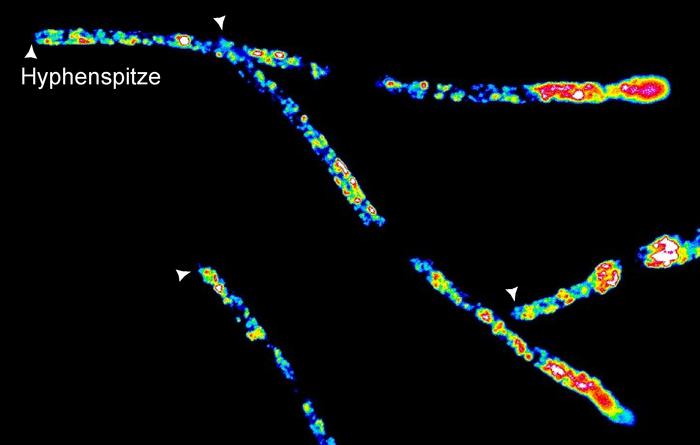Fungal infections pose a threat to humans, animals and plants, with in part serious consequences. Together with colleagues from Frankfurt/Main and Aachen, a research team from Heinrich Heine University Düsseldorf (HHU) has now clarified an important mechanism in how such infections are regulated at molecular level. In the scientific journal Proceedings of the National Academy of Sciences (PNAS), they describe how this discovery may lead to the development of new antifungal agents.

Credit: HHU/Srimeenakshi Sankaranarayanan
Fungal infections pose a threat to humans, animals and plants, with in part serious consequences. Together with colleagues from Frankfurt/Main and Aachen, a research team from Heinrich Heine University Düsseldorf (HHU) has now clarified an important mechanism in how such infections are regulated at molecular level. In the scientific journal Proceedings of the National Academy of Sciences (PNAS), they describe how this discovery may lead to the development of new antifungal agents.
As pathogenic agents, fungi can cause serious diseases in humans, animals and plants. In humans, the skin is frequently affected, for example by the largely harmless condition athlete’s foot. However, particularly in the case of a weakened immune system, internal organs may also be affected – for example, the lung disease aspergillosis is caused by moulds of the Aspergillus family. In crop plants, diseases caused by fungi can do significant damage – well-known examples include ergot, which attacks rye and is highly poisonous to humans, or corn smut, for which the fungus Ustilago maydis is responsible.
In order to develop new defence strategies to protect humans, animals and plants, it is important to understand how the infections are regulated at molecular level, above all at DNA and RNA level. However, knowledge about the RNA regulation of fungal pathogens in particular is currently still limited.
In collaboration with research groups from Frankfurt and Aachen, the working group headed by Professor Dr Michael Feldbrügge from the Institute of Microbiology at HHU applied an effective RNA marking technique for fungi, which functions in the living organism (“in vivo”). The researchers found out how an important RNA-binding protein (for short: RBP) called Khd4 regulates the growth of infectious hyphae – the filament-like form of the fungi, only this form triggers an infection.
An important factor for the growth of infectious hyphae is membrane trafficking: a recycling process that enables the exchange of material between the fungus and its environment by using organelles such as vacuoles.
Determining the stability of information-transmitting mRNAs was an important aspect in the published work. By nature, RNA is not very stable and actively degrades. The protein amount is regulated via the mRNA degradation.
Professor Feldbrügge: “For the first time, we have discovered a new regulatory concept for infections: A single RBP controls the polar growth of infectious hyphae by determining the stability of mRNAs, which in turn regulate membrane trafficking. This opens up points of attack for developing new fungicides, which use RBPs as new targets for fighting fungi.”
The research work was conducted in close collaboration between various facilities at HHU and with external partners. The lead author and PhD student Srimeenakshi Sankaranarayanan and Dr Carl Haag, who are both funded by the Manchot Graduate School “Molecules of Infection” (MOI), primarily focused on comparing plant and human pathogenic fungi. The RNAs were sequenced at the Biological Medical Research Centre (BMFZ) at HHU. The cooperation partner, Dr Kathi Zarnack from the Goethe University Frankfurt am Main, completed the bioinformatic analysis in the project.
“One important aspect was the mathematical modelling, in which the groups working on the theoretical and experimental aspects were closely integrated,” emphasized Professor Feldbrügge: “This form of cooperation is part of the fundamental concept of our Collaborative Research Centre ‘MibiNet’, which was launched in 2023. The contribution of Professor Dr Anna Matuszyńska from Aachen University of Technology (RWTH) was key to the success of the project.”
Original publication:
Srimeenakshi Sankaranarayanan, Carl Haag, Patrick Petzsch, Karl Köhrer, Anna Matuszyńska, Kathi Zarnack, and Michael Feldbrügge; The mRNA stability factor Khd4 defines a specific mRNA regulon for membrane trafficking in the pathogen Ustilago maydis. PNAS (2023).
DOI: 10.1073/pnas.2301731120
Journal
Proceedings of the National Academy of Sciences
DOI
10.1073/pnas.2301731120
Article Title
The mRNA stability factor Khd4 defines a specific mRNA regulon for membrane trafficking in the pathogen Ustilago maydis
Article Publication Date
17-Aug-2023




